

Pandemic shows how 'digital by default' government services exclude those who need them most. The internet and other digital technologies have helped many of us cope with lockdown, and new ways of working have quickly become commonplace.

But the pandemic has also exposed the “digital divide” across the UK – and the fact that not everyone has access to a computer, tablet, laptop or smartphone – or has an internet connection in their home. And with many pupils still having to study at home, for families that rely on mobile phones for an internet connection, online learning comes at a high price. There is a significant overlap between groups at high risk of COVID-19 and homes without internet access. A recent report from Ofcom found that in the UK 43% of people age 75 and over do not have any kind of home internet connection. Nor do 26% of people age 65-74, or the 24% of people who work in semi-skilled and unskilled manual jobs. How to Write an Awesome Website Content Review. Recently I wrote a Website Content Review plan for a client’s large website which contained a detailed breakdown on how to improve readability, accessibility and usability for their users.
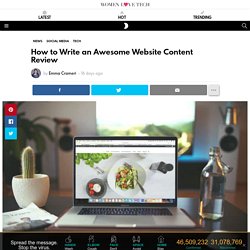
An organization’s website is the most important online content asset. However, it needs to share a common look and feel with the rest of the organization’s social media platforms and channels. A website content review will ensure that each of these elements are looking and working together professionally and cohesively. Website Content Review A Website Content Review needs to be completed regularly (perhaps annually) to ensure the website is meeting your goals and objectives. Acts falling outside the scope of copyright infringement - Arts Law Centre of Australia. At the time of authoring this article, Joel Barrett was a legal volunteer at Arts Law.
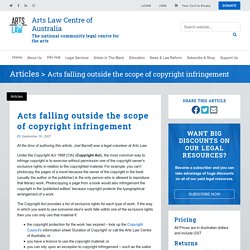
Under the Copyright Act 1968 (Cth) (Copyright Act), the most common way to infringe copyright is to exercise without permission one of the copyright owner's exclusive rights in relation to the copyrighted material. For example, you can't photocopy the pages of a novel because the owner of the copyright in the book (usually the author or the publisher) is the only person who is allowed to reproduce that literary work. Photocopying a page from a book would also infringement the copyright in the 'published edition' because copyright protects the typographical arrangement of a work. Moodle. The creation or development of any eLearning course begins by defining the "goal" (i.e., keeping the end in mind). 1.
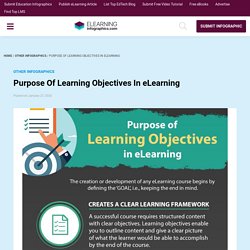
Create A Clear Learning Framework A successful course requires structured content with clear objectives. Learning objectives enable you to outline the content and give a clear picture of what the learner would be able to accomplish by the end of the course. 2. The best way to create an amazing learning experience is to define the scope of the training and clearly communicate this to the learner. 3. When the content is presented with a clear purpose, learners can navigate through the course with ease, extracting the right kind of information.
Study Tips. Analytics. Infographics. eLearning Assessment. Flipped Classroom. eLearning Course Creation. 8 Types Of eLearning Analytics To Obtain From Google And Your LMS - eLearning Industry. Pedagogy.
Knowledge Management. Digital Literacy PD & Reading. Technology. Digital Literacy. 7 Tips for Developing an eLearning Strategy Infographic. E-Learning Infographics 7 Tips for Developing an eLearning Strategy Infographic 7 Tips for Developing an eLearning Strategy Infographic The 7 Tips for Developing an eLearning Strategy Infographic provides some tips and ideas to think about when developing an elearning strategy. 1.
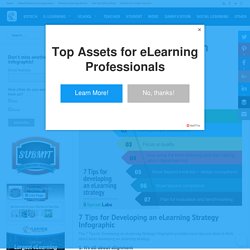
It’s all about alignment Your eLearning strategy should be aligned with your organisation’s goals for the future. 2. A principle-based approach enables flexibility. 3. eLearning has a quality problem. 4. Marketing professionals no longer talk about online or mobile marketing, they talk broad-term digital marketing. EdTech Toolbox: Ultimate Web 2.0 List. 50 Great EdTech Tools for Teachers and Educators ~ Educational Technology and Mobile Learning. April, 2015 Looking for some powerful EdTech tools to try out in your class or probably use for your professional development?
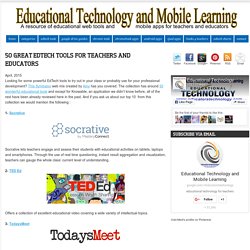
This Symbaloo web mix created by Amy has you covered. The collection has around 50 wonderful educational tools and except for Knowable, an application we didn’t know before, all of the rest have been already reviewed here in the past. Tech Tools by Subject and Skills. Every year, so many new technology tools for teachers are launched into the market that it can be nearly impossible to keep up with them all.
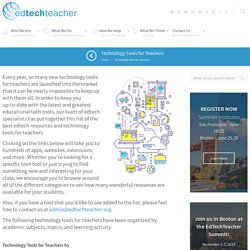
In order to keep you up-to-date with the latest and greatest educational tech tools, our team of edtech specialists has put together this list of the best edtech resources and technology tools for teachers. Clicking on the links below will take you to hundreds of apps, websites, extensions, and more. Whether you're looking for a specific tech tool or just trying to find something new and interesting for your class, we encourage you to browse around all of the different categories to see how many wonderful resources are available for your students. Also, if you have a tool that you'd like to see added to the list, please feel free to contact us at admin@edtechteacher.org.
The following technology tools for teachers have been organized by academic subjects, topics, and learning activity. Stoodle. Sketchnoting. 10 Essential Online Tools For Distance Learning - eLearning Industry. Let’s begin by allaying your fears.
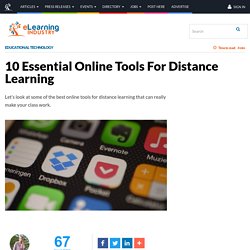
Online tools for distance learning will not replace you as the teacher. At least, not yet. Instead, they offer unique opportunities to teach in different ways that aren’t possible in traditional classrooms. And that is something that should always be embraced. But rather than replacing normal teachers, they seem to enhance their lessons. So don’t be afraid of the new online tools for distance learning that are out there. 1. The modern classroom isn’t complete without a collaborative website that allows you to put together videos as a group. 2. Scribble might not be the most complex of tools, but I personally see that as a bonus rather than a hindrance, as it means it’s in everybody’s reach. 3.
eLearning Press Release Do's and Don'ts - eLearning Industry. An eLearning press release tells a story.

That story may be fact-filled and to the point, but it’s a story all the same. As such, every eLearning press release writer needs to know how to craft a marketing tale with a newsworthy twist. Otherwise, readers may be confused instead of curious, which prevents them from seeking out more information. 5 Tips To Enhance Your Professional Development Strategy Through Social Media - eLearning Industry. That was the time when majority of us think that social media is just all about going out there and making friends.
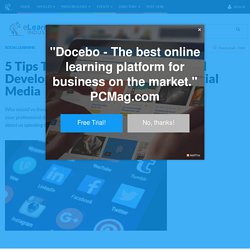
This is a very big misconception; we are now at a time where websites and applications are more powerful than just increasing our number of online friends. With the wide array of online training courses in various industries nowadays, we can conveniently enhance our skills to build our professional network. So instead of just bumming around the worldwide web, we might as well put our time to good use and improve our professional strategy while we’re at it. Here are 5 tips on how to use social media platforms to enhance your professional development. 4 Big Business Benefits Of Custom eLearning - eLearning Industry. Custom eLearning does what off-the-shelf training products cannot: presents tailor-made content that speaks directly to your audience. Investing in custom eLearning solutions comes with a host of benefits for your business and learners and will help you reach your desired training goals while bringing measurable business impact.
6 eLearning Content Chunking Strategies To Apply In Instructional Design - eLearning Industry. Content chunking, as its name suggests, involves chunking information so that it’s easier for online learners to digest. Instead of memorizing multiple concepts, online learners have the power to analyze each concept on its own. Once they’ve assimilated the eLearning content, they are free to move onto the next concept. Content chunking was first introduced by George A. Miller in 1956. 9 Things You Should Know About Digital Skills Infographic.
Other Infographics 9 Things You Should Know About Digital Skills Infographic 9 Things You Should Know About Digital Skills Infographic As skills go, there are none so in demand as ones in digital. As the digital economy continues to thrive and companies embark on or undergo digital transformation, talented professionals with the right digital skills are becoming more difficult to find. On the flip side, while this demand creates huge employment opportunities, many graduates and professionals are struggling to keep apace with digital technologies making their knowledge outdated and out of touch. eLearningDom. How to Build a Student Portfolio Infographic. Educational Technology Infographics How to Build a Student Portfolio Infographic How to Build a Student Portfolio Infographic By definition a portfolio is a container of documents that provide evidence of someone’s knowledge, skills, and/or dispositions (Barton & Collins, 1993; Bird, 1990).
Today’s students are the most accomplished and the most connected. Back in the day, no one needed a resume until they were out of school. Via: kudoswall.com. 10 Mobile Apps Instructional Designers Should Be Familiar With - eLearning Industry. Many Instructional Designers already use mobile devices in their eLearning strategy. They give online learners the power to access valuable online resources and improve their skills from anywhere in the world. However, we can also use mobile apps to our advantage. 10 Mobile Apps Instructional Designers Should Be Familiar With - eLearning Industry. 6 Strategies For Developing Human Interest Technical Writing - eLearning Industry.
Getting Started With Knowledge Management - eLearning Industry. In the last couple of years I’ve dealt with a few companies that were either unable or unwilling to preserve the knowledge and expertise of their employees. In fact, I was employed at one such organization for quite some time. The company lost money and opportunities, and its image suffered as well, all due to the lack of a comprehensive knowledge management solution. In regards to training, the company put faith in the old “knowledge sharing is king” motto.
However, they paid little more than lip service to the concept. 9 Ways To Use Social Networks In eLearning - eLearning Industry. The eLearning is a term mostly serving to describe deliberate education with advanced technical user-friendly and intuitive teaching methods. 6 Common Misconceptions About Blended Learning Infographic. Edudemic - Education Technology Tips For Students And Teachers. Technology Integration Matrix. Habits of Mind. 8 Examples of Transforming Lessons Through the SAMR Cycle. The SAMR Model for integrating technology into teaching, developed by Dr. Innovating learning and literacy with iPads in kindergarten.
Envisioning-the-future-of-education.png (1600×2263) Educational Uses of Digital Storytelling. K-12 Education Tips & Strategies That Work. Connecting educators to what works. Edudemic - Education Technology Tips For Students And Teachers. Technology Integration Matrix. The eLearning Guild: Community & Resources for eLearning Professionals.